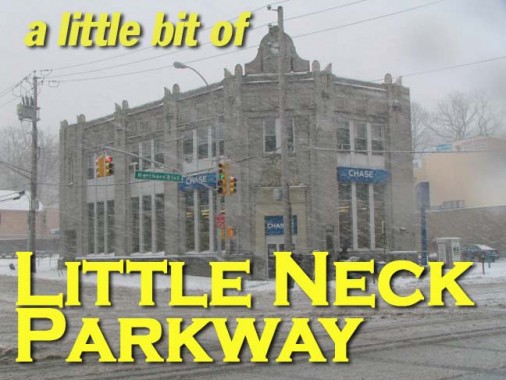After moving to Little Neck in 2007, I have taken a lot of photos in my new town, but have been saving them for the right time to use them, which would coincide with getting sufficient research. I’ve been frustrated in that — sources are scattered about and have been hard to pull together. I live in the northeasternmost extermity of New York City, and my own particular corner of Little Neck was the site of a 1907 development by Rickert-Finlay called Westmoreland. The street layout of the development remains largely intact — with the north-south streets, Westmoreland, Morgan, and Glenwood, still on the map, and little east-west streets that are now numbered.
On this 1909 atlas, Westmoreland is at the top and a neighboring development, Marathon Park, is at the bottom. The street layout is largely the same as it was in 1909, with most of the names changed. Old House Landing Road is the present Little Neck Parkway, Prospect Road is now Depew Avenue (south) and Little Neck Parkway (north). Clinton Avenue is now Marathon Parkway. The small yellow squares are houses, so the region was, as yet, sparsely populated.
The Cutter Avenue and B.H. Cutter on the map refer to Bloodgood H. Cutter, potato farmer, poet and acquaintance of Mark Twain, who immortalized him as the “Poet Lariat” in his travelogue, Innocents Abroad. Twain poked fun at Cutter as a master of doggerel who annoyed fellow passengers on an excursion to the Holy Land in the book. The John Waters on the map was a Matinecock Indian who owned the parcel between Broadway (Northern Boulevard), Marathon and Little Neck Parkways. Waters lived for over a century.
As Yogi said, when you come to a fork in the road, take it. I live just up the road from a classic Y-shaped fork road, with Little Neck Parkway on the left and Marathon Parkway on the right.
The very first address on Marathon Parkway after it branches from Little Neck Parkway looks for all the world like an abandoned farmhouse. Several windows are cracked, the window sashes are collapsing, trash is strewn in the front yard, the corral-like fence is broken in several areas, the windows are mostly covered with either Hefty bags or canvas, and if you pass by at night, you can see that a room on the interior is illuminated by a single light bulb. It’s as if Your Webmaster is glimpsing his retirement.
My favorite building on Little Neck Parkway is PS 94 (the David D. Porter School). It may be the northeasternmost public school in Queens. I’ve always found information on public schools sketchy and hard to come by — their websites are, after all, concerned with education and not building histories. As thisDouglaston/Little Neck Historical Society page shows, the school was built in 1913; it’s unique in design compared to other public schools in NYC, and is painted pale yellow.
That webpage, by the way, contains plenty of photos of old Westmoreland and Little Neck.
This house on the west side of Little Neck Parkway just south of the Staples parking lot may have been on the parcel when John Waters owned it. The tree is so huge, it has to have been here for a century. What kind of tree is it?
Paul Graziano of Historic Districts Council: The house behind Staples – which is from around 1905 – is owned by LaRock Waters, as is the small house behind that, which they recently got back from NYC. He is the direct descendant of the Waters family which has inhabited that intersection for *at least* 700 years…I have documentation. They are Matinecock Indians – I actually live next door to his niece in north Flushing – and where the Scobee Diner is was the original farmhouse, which was from 1806. They actually owned all the land up to Cornell Lane which was ex-appropriated from them when Northern Blvd. was widened in the 1920s. Their family cemetery was partially exhumed and there is a grave dedicated to the Matinecocks at Zion Church. The tree is over 200 years old, by the way.
The other house that looks abandoned is, in fact, inhabited by LaRock’s cousins. They are very strange, but that house was built by their family in the mid-19th century and they’ve been there ever since.
The Moderne bank at Little Neck Parkway and Northern Blvd., with its formidable eagle, was designed in 1927 by Paul LaVelle, who had previously worked with Stanford White. Originally the Little Neck National Bank, it was initiated by local realtor Bryce Rea, William Hutton and William Van Nostrand. It has been a Chase branch for over 30 years.
The Scobee Diner, along with the Bayside, Landmark and Seven Seas, is one of many diners lined up along Northern Blvd. from Bayside to Port Washington. It was constructed by the Kullman Diner Co. in 1965 and underwent a renovation by DeRaffele as recently as 2006. Former CIA Director George Tenet was an employee in the 1960s.
[The Scobee Diner, despite a busy clientele, closed November 30, 2010 and has remained abandoned up to this update, 1/28/12. In the weird world of real estate, the owners of the property consider it more valuable closed than open.]
The Doyle B. Shaffer Funeral Home, across from Chase. My original intention had been to continue south on Little Neck Parkway to the LIE and get lunch at Five Guys, but if I don’t get out of this, I’ll be making a premature visit to Shaffer.
So, it’s back to the Westy, ah, Westmoreland Gardens, my apartment complex. It was constructed in 1941 on Little Neck Parkway south of 40th Avenue.
Photographed February 10, 2010; page completed February 15
